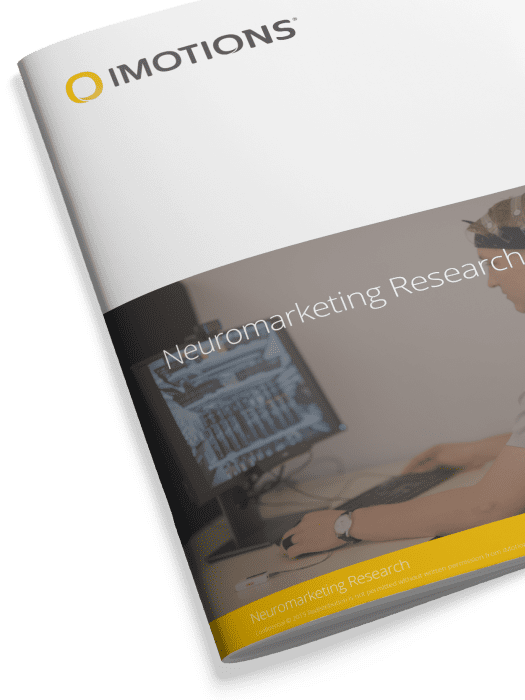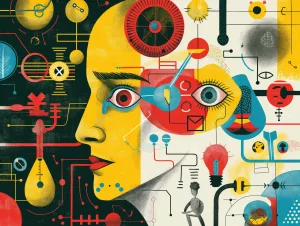Neuromarketing is being used in a diverse range of industries and is a powerful tool for understanding human behavior and building your emotional branding. Tapping into real-time emotional responses allows you to understand consumer preferences and attitudes towards a product, a visual, and even an experience. This ‘emotional branding’ has been scientifically linked to help build awareness, trust and ultimately, loyalty.
Many traditional marketing techniques such as focus groups and A/B testing allow the participants to recall their experience but do not measure real-time reactions to what they are actually feeling and can be limited to the participants’ recall ability. Biosensors give you the “how” and “when” and combine with self-report (recall) to explain the “why.”
Neuroscience
- What do people have cognitive-emotional reactions to?
- How intense are those cognitive-emotional responses?
- How frequently do those responses occur?
- What gets overtly noticed, and what gets ignored or goes missed?
- What are the underlying biological mechanisms that can drive behaviors?
“Traditional” Methods
- Why do people believe they respond to certain stimuli, and not others?
- Why do people believe they prefer stimulus A over stimulus B?
- What do people consciously remember from an experience?
Leverage the power for biosensor research in Consumer Behavior
Myth 1
People who have used your brand before will remember you better – False
Neuromarketing in TV advertising
The University of South Australia investigated whether brand usage made an impact on advertisement recall of 700 participants with 64 advertisements.
Research Tools: iMotions software platform, survey tool and Eye-tracking hardware
Conclusion: The results showed that though you have used the brand before, it does not mean you will have it top of mind when shown a series of adverts that you must recall (this excludes heavy users of the brand). These findings highlight the importance of developing advertising to gain visual attention from potential and repeat customers.
Myth 2
Public service announcements need to be scary to help change behavior – False
Neuromarketing in Public Services Announcements (PSA)
Our collaboration with BONCOM has allowed them to create more memorable Public Service Announcements (PSA) using biosensors and iMotions.
Research Tools: iMotions software with galvanic skin response (GSR), electroencephalography (EEG), facial expression analysis (FEA), and eye tracking (ET) – to complement their traditional survey-based methods to evaluate eight distracted driving PSAs.
Conclusion: Utilizing humor that is fresh, non-repetitive, and has a sensible story around it had the most positive responses. They concluded that shorter, humorous PSAs were ultimately more memorable with their target group than shock and scare tactics that were used before.
- Check out the Neuromarketing Science & Business Association – NMSBA Year Book 2020 for our case study
Myth 3
Consumers are completely rational shoppers – False
Neuromarketing in Shopping Experience
The Rational choice theory in economics states that we are rational and will make decisions to maximize the outcomes in our favor. We will evaluate with information, pros, and cons, price comparisons, and will pick the best of all the outcomes. The opponents of this theory in behavioral economics have proven very different outcomes, as people tend to buy irrationally and more on cognitive biases.
These biases explain how people are experiencing the store or website. It can help explain how people make decisions, what motivates people to seek out more information and eventually why they choose to buy the product.
A great example of neuromarketing in action is GlaxoSmithKline (GSK). GSK uses iMotions for its Shopper Capability and User Experience with focus groups inside their lab setting. They test shop layout, product packaging, e-commerce, shopper toolkits, and everything relating to shopper decisions.
Research Tools: iMotions software, Eye tracking, ECG (electrocardiography), EEG (electroencephalography), GSR (Galvanic Skin Response or Electrodermal Activity or EDA)
Conclusion: UX researchers are increasingly using biosensors to advance their understanding. These methods are best used in combination with traditional methodologies that provide the foundation of understanding, while the biosensors provide the data for a deeper comprehension of user experience.
Myth 4
Mobile advertising is a great way to reach your audience – Somewhat false
Neuromarketing in Mobile Advertising
User experience with mobile ads can leave a bad impression if not properly thought out. It should not take away from the overall experience of the product and will help users stay engaged with the ads. A recent study by Dartmouth College tries to understand how to optimize mobile ads with UX.
Research Tools: iMotions software to collect data streams garnered from the brain and body, including visual fixations, heart rate (ECG), electroencephalography (EEG), skin conductance (GSR), and facial affect (FEA).
Conclusion: Your mobile marketing strategy should understand how users interact with your ads and when they are shown. Results showed that three practices led to positive user experience with advertisements: maintaining user volition to engage with advertisements, limiting the disruptive nature of advertisements, and incentivizing viewing.
- Check out The Top 5 Neuromarketing Research Studies
- Check out our video with Spark Neuro on how they optimize ads for Angry Birds
Myth 5
Having a celebrity endorsement helps your brand – Somewhat false
Effectiveness of Celebrity Branding and Celebrity endorsements
Karachi Inistuite of Business Administration conducted a study using 30 respondents to investigate the overshadowing effect of a celebrity.
Research Tools: iMotions software with eye tracking
Conclusion: Research showed that having a celebrity endorsement with your advertisement can actually take away from your brand’s attention. It may initially help capture the visual attention of the audience but can, unfortunately, eclipse the brand altogether. This phenomenon is coined Brand Visual Eclipse and it’s something marketers need to keep in mind when using celebrity endorsements.

Neuromarketing is utilized within a broad range of commercial testing. There are many examples of neuromarketing research in practice, as well as how information is shared and processed to help with the buyer’s journey. Ultimately, removing the friction, showcasing the ads correctly, and optimizing the user experience to have positive associations, are all ways to build emotional branding and brand loyalty.
References
Ali Ekber, Akgün İpek Koçoğlu, Salih Zekiİmamoğlu. An Emerging Consumer Experience: Emotional Branding. Procedia – Social and Behavioral Sciences Volume 99, 6 November 2013, Pages 503-508. https://doi.org/10.1016/j.sbspro.2013.10.519
Kim, Y., Sullivan, P. Emotional branding speaks to consumers’ heart: the case of fashion brands. Fash Text 6, 2 (2019). https://doi.org/10.1186/s40691-018-0164-y
Singla, V., & Gupta, G. (2019). Emotional Branding Scale and Its Role in Formation of Brand Trust. Paradigm, 23(2), 148–163. https://doi.org/10.1177/0971890719859668
Download
Neuromarketing Brochure
For Beginners and Intermediates











